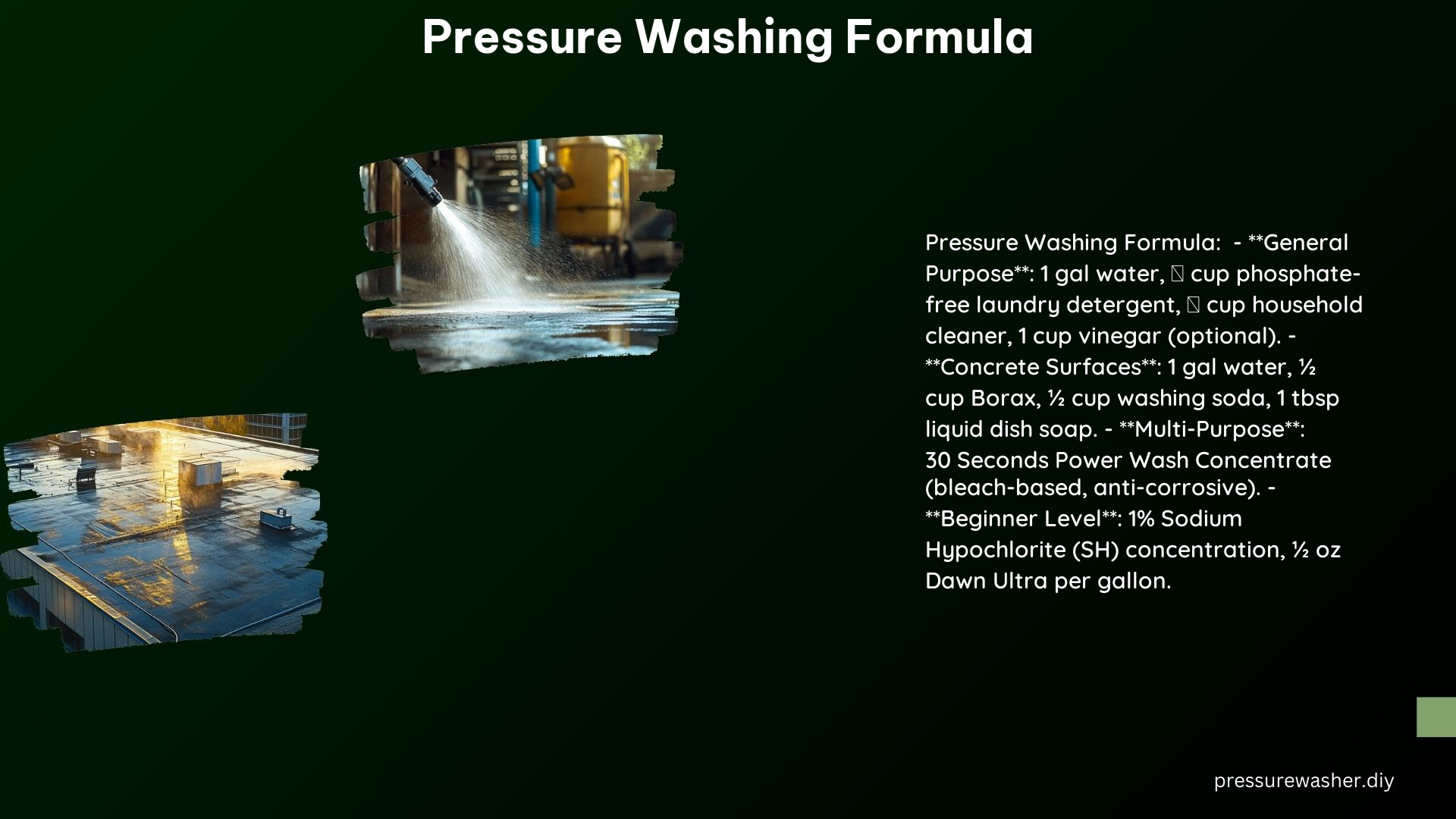Pressure washing is a powerful technique for cleaning various surfaces, from driveways and patios to siding and roofs. However, the success of pressure washing largely depends on the formulation of the cleaning solution. In this comprehensive guide, we’ll dive deep into the science and art of pressure washing formulas, equipping you with the knowledge and tools to tackle any cleaning challenge with confidence.
General Purpose Pressure Washing Formula
For general cleaning of surfaces, a well-balanced pressure washing formula can be created by mixing the following ingredients:
- 1 gallon of water
- ⅓ cup of phosphate-free laundry detergent (powder)
- ⅔ cup of household cleaner
- 1 cup of vinegar (optional)
This formula is designed to effectively remove dirt, grime, and other common surface contaminants. The detergent helps to break down and lift the dirt, while the household cleaner and vinegar (if used) provide additional cleaning power and help to neutralize any lingering odors.
Concrete Surfaces Pressure Washing Formula

When it comes to cleaning concrete surfaces, an environmentally friendly approach is often preferred. The following formula is a great option for this purpose:
- 1 gallon of water
- ½ cup of Borax
- ½ cup of washing soda
- 1 tablespoon of liquid dish soap
Borax and washing soda are natural, non-toxic cleaning agents that work together to break down and remove stubborn stains and buildup on concrete. The liquid dish soap helps to emulsify and lift the dirt, leaving your concrete surfaces sparkling clean.
Beginner-Level Pressure Washing Chemicals
For those new to pressure washing, starting with a simple and effective formula can be a great way to build confidence and experience. A good beginner-level pressure washing solution includes:
- Dawn Ultra detergent
- Sodium Hypochlorite (SH) at a 1% concentration (e.g., 1/2 ounce per gallon of water)
Dawn Ultra is a popular and widely available dish soap that can be used as a versatile cleaning agent in pressure washing applications. The addition of a small amount of Sodium Hypochlorite (a common bleaching agent) can help to enhance the cleaning power of the solution, particularly for removing stubborn stains and discoloration.
Diesel-Fired Pressure Washer BTU Calculation
When using a diesel-fired pressure washer, it’s important to understand the relationship between the nozzle size and the BTU (British Thermal Unit) output of the machine. The BTU can be calculated by multiplying the nozzle size by 140,000 at 100 psi fuel pressure.
For example, if you’re using a 3.5 GPM nozzle, the BTU output of your diesel-fired pressure washer would be:
3.5 GPM x 140,000 = 490,000 BTU
Knowing the BTU output of your pressure washer can help you select the appropriate cleaning solutions and adjust the pressure and flow rate to achieve optimal cleaning results.
Horsepower Requirements for Pressure Washers
The horsepower requirements for pressure washers can be calculated using the following formulas:
Electric Pressure Washers:
Electric HP = (psi x gpm) / 1460
Gas-Powered Pressure Washers:
Gas Engine HP = (psi x gpm) / 1100
These formulas take into account the pressure (psi) and flow rate (gpm) of the pressure washer to determine the required horsepower. Understanding the horsepower requirements can help you select the right pressure washer for your specific cleaning needs and ensure that your machine has the necessary power to handle the job.
Other Pressure Washing Formulas and Tips
Boiling Point of Water
The boiling point of water in a pressure washing system can vary significantly depending on the pressure. At 30 psi, the boiling point is around 250°F, while at 3000 psi, the boiling point can reach up to 695°F. This information is crucial when working with hot water pressure washers, as it can help you understand the potential risks and adjust your cleaning process accordingly.
Nozzle Size and BTU
As mentioned earlier, the BTU output of a diesel-fired pressure washer can be calculated based on the nozzle size. This relationship is important to understand, as the nozzle size directly affects the flow rate and pressure of the cleaning solution, which in turn impacts the overall cleaning performance.
Surfactants
Surfactants are essential ingredients in pressure washing formulas, as they help to reduce the surface tension of the cleaning solution, allowing it to penetrate and lift dirt and grime more effectively. When using bleach or other strong chemicals in your pressure washing solution, the inclusion of surfactants becomes even more critical for achieving optimal cleaning results.
Commercial Pressure Washing Products
While you can create your own pressure washing formulas, there are also several commercial products available that are designed for specific cleaning tasks. Two popular options include:
-
ZEP House and Siding Pressure Wash: A concentrated formula designed for use in pressure wash machines with downstream injectors. This product is formulated to effectively clean a variety of outdoor surfaces, including siding, decks, and driveways.
-
30 Seconds Power Wash Concentrate: A multi-purpose cleaner powered by bleach, making it suitable for a wide range of outdoor surfaces, from concrete to vinyl siding.
Safety and Precautions
When working with pressure washers and cleaning chemicals, it’s essential to prioritize safety. Always follow the manufacturer’s instructions and safety guidelines, and take the following precautions:
- Wear appropriate personal protective equipment (PPE), such as safety goggles, gloves, and a face mask or respirator.
- Ensure proper ventilation, especially when using chemicals with strong odors or fumes.
- Test cleaning solutions on small, inconspicuous areas before applying them to larger surfaces to ensure compatibility and effectiveness.
- Properly dispose of any leftover chemicals or cleaning solutions according to local regulations.
By understanding the science behind pressure washing formulas and following best practices for safety, you can unlock the full potential of this powerful cleaning technique and tackle even the toughest cleaning challenges with confidence.
